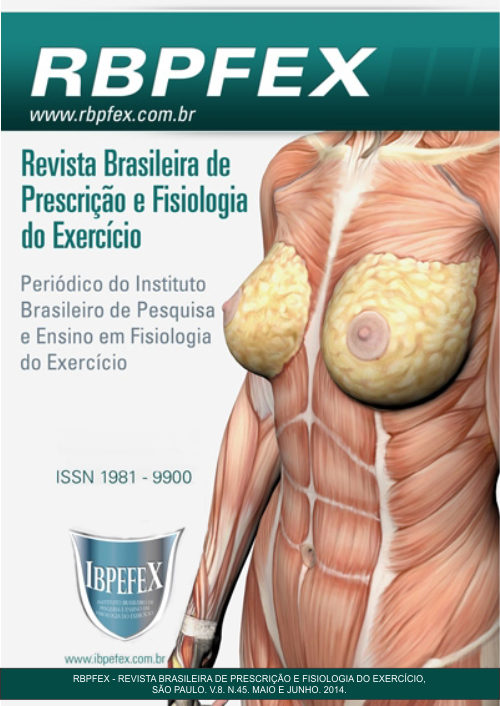Subject perception of exertion in different types of squat exercise
Abstract
The aim of this study was compare the perceived exertion (PE) related to the strength, balance, coordination and overall effort after two distinct forms of the squat exercise: traditional parallel squat with bar (TRAD) and parallel squat with lateral shift weight with load 50% of that used in TRAD (FUNC). Seven volunteers (three women, four men, 31.7+5.7 years) experienced in resistance training and functional participated of study. They performed TRAD and FUNC, with a rest interval of five minutes between both, and instructed to fill out the PE immediately after each exercise. The PE after FUNC was higher than TRAD for the variables Balance (4.0+1.9 vs. 2.7+0.8), Strength (4.9+2.1 vs. 4.1+2.1) and Effort Overall (5.0+2.0 vs. 4.1+2.0), with a significant difference (P<0.05). For the Coordination, the PE was not statistically different between the two situations; however the absolute value of the PE average in FUNC was 53.9% higher than in TRAD (4.0+1.9 vs. 2.6+0.5). It is concluded that the squat FUNC –even using a load of 50% of TRAD –was perceived as more intense, being an interesting option when you want to boost strength, balance, coordination and training intensification, however using smaller external loads while minimizing overload on non-contractile structures.
References
-Borg, G. Borg's perceived exertion and pain scales. Champaign. Human Kinetics. 1998.
-Clark, M.A. Integrated core stabilization training. Thousand Oaks. National Academy of Sports Medicine, 2001.
-Marchetti, P.; Calheiros, R.; Charro, M. Biomecânica aplicada: uma abordagem para o treinamento de força. São Paulo. Phorte. 2007.
-Monteiro, A.G.; Evangelista, A.L. Treinamento funcional: uma abordagem prática. São Paulo. Phorte. 2010.
-Nakamura, F.Y.; Moreira, A.; Aoki, M.S. Monitoramento da carga de treinamento: a percepção subjetiva do esforço da sessão é um método confiável?. Revista da Educação Física/UEM. Maringá. Vol. 21. Num. 1. p. 1-11. 2010.
-O’Sullivan, S.B.; Schmitz, T.J. Fisioterapia: Avaliação e tratamento, 4ª edição. Manole. 2004.
-Oliveira, R.F.; Matsudo, S.M.M.; Andrade, D.R.; Matsudo, V.K.R. Efeitos do treinamento de Tai Chi Chuan na aptidão física de mulheres adultas e sedentárias. Revista Brasileira de Ciência e Movimento. Vol. 9. Num. 3. p. 15 -22. 2001.
-Silva, K.R.A.; Freitas, D.K.S.; Santos, E.A.; Martins, M.O. Análise da Complexidade e Intensidade Percebida em Exercícios de Programa de Treinamento Funcional para Idosos. Revista Piauiense de Saúde. Teresina. Vol. 1. Num. 2. p. 4-11. 2012.
-Thompson, W.R. Worldwide survey of fitness trends for 2013. ACSMs Health and Fitness Journal. Vol. 16. Num. 6. p.8-17. 2012.10-Weineck, J. Treinamento ideal. 9ªedição. Manole. 2003.
Authors who publish in this journal agree to the following terms:
- Authors retain the copyright and grant the journal the right of first publication, with work simultaneously licensed under the Creative Commons Attribution License BY-NC which allows the sharing of the work with acknowledgment of the authorship of the work and initial publication in this journal.
- Authors are authorized to enter into additional contracts separately for non-exclusive distribution of the version of the work published in this journal (eg, publishing in institutional repository or book chapter), with acknowledgment of authorship and initial publication in this journal.
- Authors are allowed and encouraged to post and distribute their work online (eg, in institutional repositories or on their personal page) at any point before or during the editorial process, as this can bring about productive change as well as increase impact and impact. citation of published work (See The Effect of Free Access).






